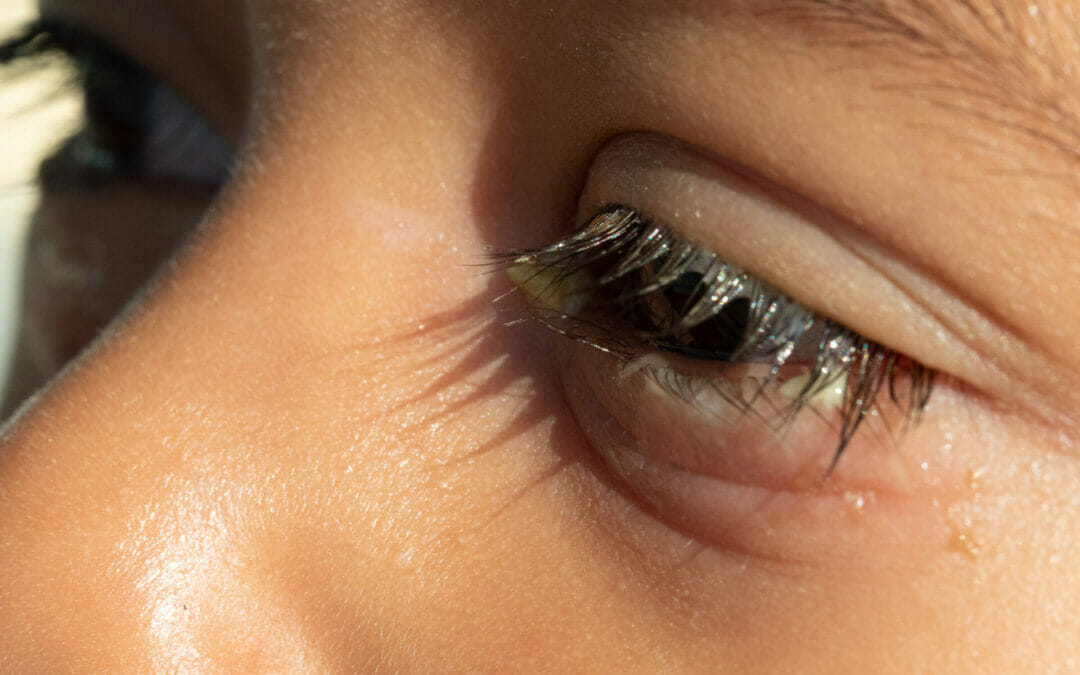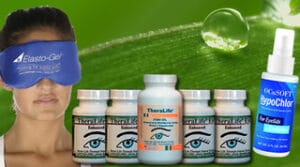Eyelash mites cause two types of Demodex blepharitis. The bacteria eat dead skin cell cellulose. Typically symptoms can be painful redness and swelling of the eyelashes and lips. Eye hygiene can reduce mite infestation.
Eyelash mites is one type of Blepharitis – inflammation of the eyelids. Root cause is chronic dry eyes. Therefore, it is paramount that we treat dry eyes, blepharitis and clogged meibomian oil glands ( the trifacta of dry eyes) simultaneously to get optimum results.
Treat Your Dry Eyes To Get Rid of Eyelash Mites- Demodex Blepharitis
Demodex blepharitis is caused by eyelid inflammation. The root cause is chronic dry eyes. Theralife treats dry eyes, reduce inflammation, help you produce more tears and optimize cellular function from inside out.
TheraLife Eye Enhanced All-in-One Starter Kit
Everything you need to get rid of eyelash mites- Demodex Blepharitis
Clinically proven, Money back guaranteed.
Add To CartCustomer success story
Blepharitis MGD Recovery
I have had blepharitis/MGD that would come concurrent with a pink eye for quite a few years, but it has always gone away pretty quickly on its own. However, this last time, blepharitis and dry eye did not leave, and it became pretty disruptive to my life. My eye doctor gave me eye drops, making my eyes feel drier. I felt as though I had no hope for my eyes, and they were going to keep getting worse and worse. Despite being reasonably skeptical, I finally decided to try Theralife, and I’m So glad I did. I’ve now been taking it for just over two weeks, and I already feel so much better. This morning I woke up, and my eyes were almost white instead of bright red. My blurry vision cleared up, the stickiness gone from my eyes, and the stinging had virtually gone.
I’m looking forward to them getting better and better. Thanks so much!”
Cindy, USA
What are Eyelash Mites (Demodex)?
Eyelash mites, or Demodex mites, are normal parts of the body’s microbiome.
Eyelash Mites, or Demolex mites, is a parasite that lives in eyelash hair follicles. This tiny mite feeds on the dead skin cells surrounding the eyelashes and the eyelid follicle. Demolex mites can grow as small insects in cigar shapes or even scabby. They are almost three millimeters wide. Each leg consists of 4 pairs totaling 8 pairs.
They have a short life cycle, about 14 to 18 days, during which they feed on the oils and dead cells that are there. Leave waste products you’re sensitive to. Make lashes grow in the wrong direction or become loose. Block oil passages around your eyelid edges. Trigger the growth of tube-shaped dandruff around the lash base.,
How do you get eyelash mites?
People can acquire eyelash mites by coming into close or direct contact with another person who has them. The affected person may have larvae or adult mites that can spread to others. People can also acquire eyelash mites from dust that contains eggs.
Demodex mites live inside hair follicles, feeding on dead skin cells and oily sebum secreted onto the hair shaft. That’s why they’re found in higher numbers around greasier areas of the body, like the eyes and nose. The mites come out of the hair follicle at night to mate and then return in the morning. For this reason, symptoms of a Demodex infestation may worsen in the morning.
Are Eyelash Mites Contagious?
In the event of a severe infestation, eyelash mites can be transmitted from person to person through close contact. The cigar-shaped bugs usually infest the base of your eyelids, causing notable symptoms. Mild infections tend to be harmless and are unlikely to get transmitted to healthy.
How to Tell if You Have Eyelash Mites (Common Symptoms)
Too many Demodex mites can cause uncomfortable symptoms that may include: Itchy or burning eyes, especially in the morning, Swollen eyelids, Crusty eyes, Red, irritated eyes, Watery eyes, Blurred or decreased vision, Falling eyelashes, and Infected eyes. If you experience a yellowish discharge on your eyelashes, mainly in the mornings, this could be a sign of a
Having a small amount of Demodex mites seems harmless, but an overgrowth of mites — called “demodicosis” — can cause a host of symptoms affecting the eyes and other areas of the face.
Demodex mites have tiny numbers that are too tiny to be seen. Eyelash mites can cause visible symptoms, and they can also cause symptoms. Often the symptoms are due to other eye problems, including pink eye (conjunctivitis). They are seeking medical attention when you suffer any of the above.
Symptoms and diagnosis Many things can cause eye problems, not just having too many eyelash mites. But symptoms include:
- Itching, Burning, and Crusty red edges on your eyelid.
- Feeling like something “foreign” is in your eye.
- Irritation inside your eyelid.
- Blurry vision.
- Eye pain.
- Unexplained tearing in your eyes.
Causes of Eyelash Mites
One of the root cause of demodex blepharitis is chronic dry eyes.
While mites are natural, some conditions can make their population grow on your skin. Demodex mite eats dead body cells, resulting in the development and spread of mite eyelashes and dandruff. Dander cause many eyelash mite infestations on the eyes that the mites eat. In the United States, people with rosacea have 18 times more rosaceous derma mites in their faces than those with no rosacea.
Two types of Demodex mites cause eyelash mites. The two types are called Demodex folliculorum and Demodex brevis. Both mites are microscopic, so you can’t see them with the naked eye. They’re naturally prevalent in your hair follicles, where they feed on dead skin cells.
Demodex mites can be transferred from one host to another through facial skin or hair contact. They move to a new host through shared makeup and cosmetics. Having a small amount of Demodex mites seems harmless, but an overgrowth of mites — called “demodicosis” — can cause a host of symptoms affecting the eyes and other areas of the face. A Demodex infestation can also exacerbate pre-existing skin conditions like rosacea and acne on the chin, the forehead, the temples, the eyelashes, and the brows. Other areas of infestation include the balding scalp, the neck, the ears, the penis, and the buttocks. Demodex folliculorum more commonly occurs on the face.
People can acquire eyelash mites by contacting another person who has them or dust containing the mite’s eggs.
Blepharitis
Eyelids persistently red, inflamed, or itchy are signs of a common eye condition called Blepharitis. Sometimes, this is caused by an excess of bacteria or clogged oil glands at the base of the eyelashes. Other times, it may result from an overpopulation of microscopic mites inside the eyelash follicles. Known as Demodex, these bugs are also associated with the skin condition rosacea. Recent studies have suggested that anywhere from 42% to 81% of people with Blepharitis also have an infestation of Demodex.
Symptoms
Common symptoms include itchiness, redness, and burning around your eyelashes.
Having too many eyelash mites can: Trigger Irritation around the eyelid, Carry bacteria there, and Leave waste products you’re sensitive to. Make lashes grow in the wrong.
Prevalence
Demodex mites are not limited to any ethnic group. That said, they commonly occur on the skin of Aboriginal people, Caucasian people, Inuit people, Maori people Nigerian people. However, experts need to fully understand the prevalence of Demodex infestations, especially eyelash mites. Some populations may have a higher chance of infestation, including medical staff and students with frequent contact with the public.
Eyelash mites occur in healthy people, so the infestation may go unnoticed unless the mites are.
Prevalence of Demodex in eyelash follicles in different populations. https://www.ncbi.nlm.nih.gov/pmc/articles/PMC4042053
Risk Factors
Does everyone have eyelash mites? Yes, everyone has eyelash mites. Most people have a small amount of them that cause no issues. People with certain skin disorders like eczema and dandruff may have more eyelash mites since they have more flaky, dead skin.
Other potential causes for eyelash mite outbreaks include other skin conditions, such as dermatitis, inflammatory acne, and alopecia. Skin infections weaken immune systems, and HIV causes Demodex mites.
Your risk for eyelash mite outbreaks includes: Inflammatory acne Dermatitis Alopecia Weakened immune systems, Skin infections HIV. These skin issues don’t cause mites, but they do cause increased flaking skin and dandruff – mite food. Mite communities flourish when they have more to feed on
You’re more likely to have too many eyelash mites if you’re an older adult or are a caregiver for one or if your immune system doesn’t work well due to a health problem or medication
5 Weakened immune system: Immunocompromised people (including organ transplant recipients, people with advanced HIV, and those undergoing chemotherapy) are more likely to experience infestations. 6 Rosacea: A condition that causes skin redness and often small, pus-filled bumps on the face. Those with rosacea may have a higher risk of developing an increased load of demodicosis. 7 Demodex mites are not transmitted from pets to owners or by living with older adults. Using shared items does not appear to increase the risk of demodicosis
Treatment Methods for Eyelash Mites
TheraLife Eye Enhanced All-in-One Starter Kit
Everything you need to get rid of eyelash mites- Demodex Blepharitis
Clinically proven, Money back guaranteed.
Add To Cart
Both at-home and medical treatment methods are highly effective at controlling an eyelash mite outbreak.
If your doctor does diagnose you with an eyelash mite infestation, they will prescribe a medicated ointment to help trap mites in place and prevent them from spreading and laying eggs. Additionally, they’ll treat any underlying skin conditions. Tea tree oil may be another option for treating Demodex mites in the eyelash area.
Since eyelash mite infestations are often asymptomatic, many people will only seek treatment when the mites multiply significantly. Demodex infestations are underdiagnosed and undertreated. The treatment goal with Demodex blepharitis is to exterminate the mites.
A fluorescent dye called fluorescein can provide excellent contrast and help identify Demodex eggs, larvae, and adult mites. The healthcare provider may also obtain an eyelash for examination under the microscope. Demodicosis is often missed in the initial diagnosis because it mimics other common eye conditions such as conjunctivitis, infectious keratitis, and dry eye syndrome. An accurate diagnosis happens once the symptoms fail to respond to the prescribed treatment.
Relieve symptoms of Eyelash Mites through a variety of measures. The treatment for Blepharitis causing eyelash mites is to avoid crust and remove the mites and their egg. In moderate to severe eyelash mites, your eye doctor can recommend the above on-site treatment methods: AOA suggests hot soaking eyelids as a top self-care tool for treating eyelash mites.
Severe cases may need the help of antibiotics or steroid eye drops or creams. Utilizing at-home and medical treatment options will likely clear up an eyelash mite infestation within a few days. Treatment approaches like Avenova, Blephadex, and Cliradex for stubborn or chronic cases can provide relief almost instantly.
Tea tree oil:
Before using tea tree oil:
- Ensure it is a 50 percent solution.
- Place a small amount of the oil solution on a cotton swab and dab it on the eyelashes, eyelids, and base of the eyelash follicles.
- Remove any excess oil.
Soaked into wipes or cleansers, rub this over your closed eyelids and face. Make sure you dilute the oil if it is full strength, as that will be too strong and harmful for your thin eyelid skin. Please don’t open your eyes quickly after wiping them, or they may sting.
One hundred percent concentrations of tea tree oil can cause swelling and redness. Dilute tea tree oil even further with walnut oil and still be effective if necessary.
Eyelash mites may also affect the cornea and cause Demodex keratitis. Some research by Trusted Source has shown that tea tree oil can eradicate eyelash mites and reduce eye surface inflammation. In this study, the participants applied tea tree oil at 50% concentration for lid scrubs and 5% for lid massages. Infections responded after a short course of tea tree oil. Other treatment options Trusted Source may include: crotamiton cream, permethrin cream, topical metronidazole oral metronidazole. In severe cases, such as in people with HIV, oral ivermectin may be effective.
Treat Your Dry Eyes To Get Rid of Eyelash Mites
TheraLife Eye Enhanced All-in-One Starter Kit
Everything you need to get rid of eyelash mites- Demodex Blepharitis
Clinically proven, Money back guaranteed.
Add To CartCan Eyelash Mites Damage Your Eyes?
Most commonly, eyelid mites are not a significant concern. However, some may induce unpleasant symptoms. They can also destroy the glands of the skin that contain sebaceous glands. If left uncovered, a parasitic infection could cause Blepharitis and demodex. Blepharitis causes inflammation of the eyelids. Blepharitis can result in various problems, including swollen eyelashes and reduced vision.
Prevention
Infestations of eyelash mites can recur, so remain vigilant about eye hygiene in the future. Throw away any eye makeup you may have used during the infestation. And, since they can spread from person to person, it’s essential to keep eye makeup private, particularly mascara.
Avoid wearing eye makeup until the no more symptoms. Change from contact lenses to eyeglasses until the treatment is complete. To avoid relapse after treatment, avoid greasy eye makeup and oil-based cleansers that can promote Demodex overgrowth. Never use someone else’s eye makeup.
TheraLife Eye Enhanced All-in-One Starter Kit
Everything you need to get rid of eyelash mites- Demodex Blepharitis
Clinically proven, Money back guaranteed.
Add To CartFrequently Asked Questions
How do you know if you have eyelash mites?
Eyelash mites are very common, but if over grown, you will experience itching, red, and burning around your eyelashes. It will be time to visit your eye doctor to confirm your diagnosis and get appropriate treatments
How do I get rid of eyelash mites?
Mites are very sensitive to Tea Tree Oil Your doctor will recommend tea tree oil eyelid washes, warm compress, and dry eye relief. Since the root cause of Demodex blepharitis is chronic dry eyes. Look into treating dry eyes to get results. Look into TheraLife.
Is it normal to have eyelash mites?
Mites are common on skin and eye lashes. They don’t normally result in symptoms of the eye. Only when they are over grown particularly in high risk people who has rosacea, skin psoriasis, immune deficiencies and chronic dry eyes. Treat your chornic dry eyes to recover from eyelash mites in blepharitis.
What causes eyelash mites?
Eyelash mites Demodex blepharitis is more common in people with ocular rosacea and facial rosacea – where the mites population is higher on the skin. Mites like to feed on dead skin, and oily secretions.
Eyelash mites are also common in people with chronic dry eyes where they develop blepharitis. Treat your dry eyes to get rid of eyelash mites, this works.
How do I get rid of eyelid mites?
One of the most effective treatment for eyelash mites is Tea Tree Oil . This tea tree oil must be diluted and used as a lash cleaner after warm compresses. If this treatment does not work, additional ointment can be prescribed by your eye doctor.
A combination of dry eye treatment and tea tree oil works well to get rid of eyelash mites and prevent recurrence.
Conclusion
The Demodex mites are frequently found in the body and may become a source of pathogenesis if they exceed the normal levels or cause inflammatory changes around the follicles. Demodex’s most commonly caused conditions include Folliculitis, Alopecia, and Rosacea.
It confirms that patients with Demodex blepharitis frequently experience and are bothered by ocular symptoms. These patients allocate time and resources to health care appointments and approaches that often do not resolve their symptoms, contributing to individual and health care system costs. Additionally, patients with Demodex blepharitis perceive significant negative effects on their daily activities, mental and physical well-being. Treatments that safely and effectively treat Demodex blepharitis and are simple to use are needed to relieve the symptom burden and reduce psychosocial effects of Demodex blepharitis.
References
Clinical Optometry: “Demodex Blepharitis: Clinical Perspectives.” American Academy of Ophthalmology: “Demodex Infestation.”
American Optometric Association: “Demodex — The Mites That Live in Our Eyelashes.” Current Opinion in Allergy and Clinical Immunology: “Pathogenic Role of Demodex Mites in Blepharitis.”
Demodicosis in Different Age Groups and Alternative Treatment Options-A Review.
Demodex Blepharitis: An Analysis of Nine Patients.
Demodex: The worst enemies are the ones that used to be friends.






